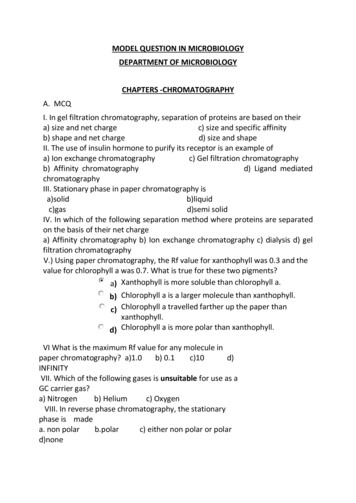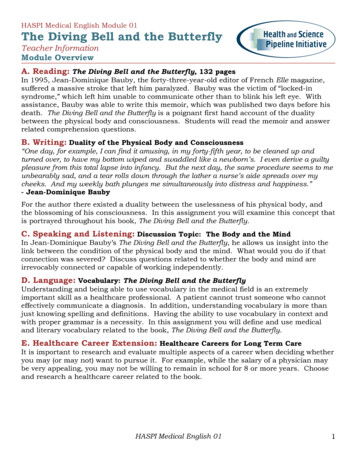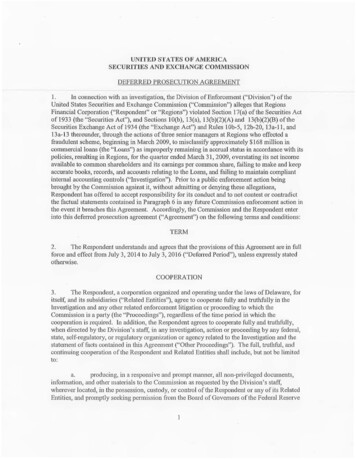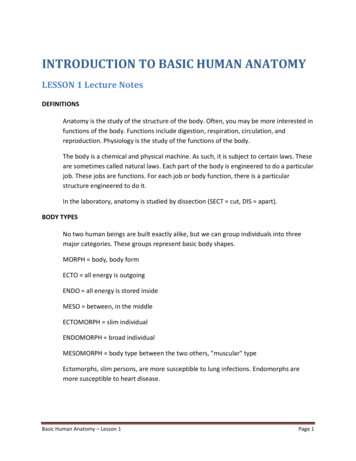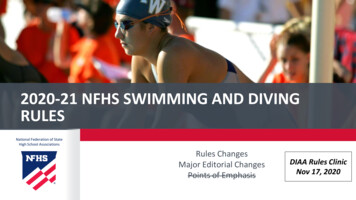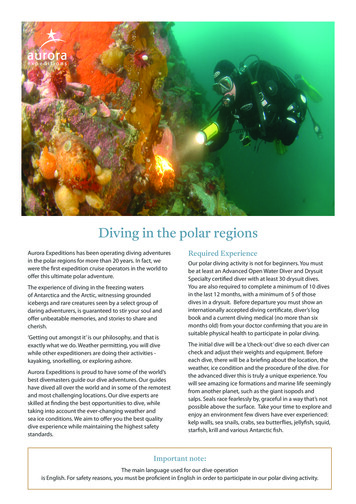
Transcription
Diving in the polar regionsAurora Expeditions has been operating diving adventuresin the polar regions for more than 20 years. In fact, wewere the first expedition cruise operators in the world tooffer this ultimate polar adventure.The experience of diving in the freezing watersof Antarctica and the Arctic, witnessing groundedicebergs and rare creatures seen by a select group ofdaring adventurers, is guaranteed to stir your soul andoffer unbeatable memories, and stories to share andcherish.‘Getting out amongst it’ is our philosophy, and that isexactly what we do. Weather permitting, you will divewhile other expeditioners are doing their activities kayaking, snorkelling, or exploring ashore.Aurora Expeditions is proud to have some of the world’sbest divemasters guide our dive adventures. Our guideshave dived all over the world and in some of the remotestand most challenging locations. Our dive experts areskilled at finding the best opportunities to dive, whiletaking into account the ever-changing weather andsea ice conditions. We aim to offer you the best qualitydive experience while maintaining the highest safetystandards.Required ExperienceOur polar diving activity is not for beginners. You mustbe at least an Advanced Open Water Diver and DrysuitSpecialty certified diver with at least 30 drysuit dives.You are also required to complete a minimum of 10 divesin the last 12 months, with a minimum of 5 of thosedives in a drysuit. Before departure you must show aninternationally accepted diving certificate, diver’s logbook and a current diving medical (no more than sixmonths old) from your doctor confirming that you are insuitable physical health to participate in polar diving.The initial dive will be a ‘check-out’ dive so each diver cancheck and adjust their weights and equipment. Beforeeach dive, there will be a briefing about the location, theweather, ice condition and the procedure of the dive. Forthe advanced diver this is truly a unique experience. Youwill see amazing ice formations and marine life seeminglyfrom another planet, such as the giant isopods andsalps. Seals race fearlessly by, graceful in a way that’s notpossible above the surface. Take your time to explore andenjoy an environment few divers have ever experienced:kelp walls, sea snails, crabs, sea butterflies, jellyfish, squid,starfish, krill and various Antarctic fish.Important note:The main language used for our dive operationis English. For safety reasons, you must be proficient in English in order to participate in our polar diving activity.
Diving in the polar regionsDiving ProcedureMarine Life at the Dive SitesDiving in these remote polar areas is not more dangerousthan normal scuba diving. However, polar diving is moreequipment and labour intensive. We always adhere to aphilosphy of safety first.The dive sites will vary from shallow ice diving, divingalong a wall or around a grounded iceberg.There is no decompression chamber and only basicmedical services on board. There is an onboard doctorto administer basic medical and first aid treatment, butAurora Expeditions cannot accept risky ventures from anyof our divers.The dives will be conducted using a buddy system of twoor three divers. If you are not travelling with a dive-buddy,don’t worry we will pair you up with other divers onboard. All divers are expected to have enough experienceto read their compass, depth gauges and look out for eachother in order to have a safe dive.Diving is an equipment intensive activity but diving inpolar regions requires an extensive amount of additionalequipment because of the cold weather and water. Ahigher level of diving experience is required for the polarregions because of the remoteness of the location. Divingis no fun if you are cold and uncomfortable. Divers in coldwater may have a higher air consumption rate, expendmore energy, and can become more fatigued. Cold wateralso decreases a diver’s ability to perform complex tasksthat require manual dexterity.If our divemaster feels that you do not meet the necessaryexperience, they have the right to exclude you fromparticipating in the dive program (this decision will bemade for your own safety and for the safety of the otherdivers). Please note that if you have been suspendedfrom diving due insufficient experience, you will not beentitled to a refund from Aurora Expeditions. All divers arerequired to follow the instructions of the divemaster andguides at all times. All participants are expected to fullyunderstand and accept the risks involved in polar divingand participate at their own choice.Booking allocation:Each diving place is for one person only.All divers are required to bring their own personalequipment, be adequately certified, have proofof recent dives, and provide evidence of medicalclearance from a doctor.The maximum depth is 20 metres / 65 feet. Thecombination of sunlight and the extraordinary formationsof ice cause an overwhelming, ever-changing spectre ofcolours, with a fantastic variety of shades and brilliance.Diving in polar areas offers opportunities to witnessspectacular ice formations in addition to interestingmarine life. In the Antarctic and Arctic waters there istypical marine life such as sea squirts, squat lobsters, manyspecies of starfish, spider crabs, soft corals, anemones,peacock worms, and dogfish. In Antarctica you may havethe possibility to snorkel or dive with seals, penguins andwhales.Number of divesWe plan to dive up to twice per day (except for daysat sea), but an exact number of dives cannot be given.It all depends on ice and weather conditions. Voyageitineraries are only a guideline and safety is always thepriority. Since this is an expedition to a remote part of theworld, unpredictable weather conditions, availability ofanchorages, wind conditions, and other factors beyondour control will always dictate when it’s safe to makea dive. Exclusive Zodiac cruising will be offered if theconditions for diving are not suitable.Number of dives
Diving in the polar regionsWhat to BringPlease contact your airline about their luggage restrictionsand request a special sporting goods allowance for yourdive equipment prior to departure. All excess baggage isat your own expense. Drysuit Hood and gloves – adequate thick wet gloves (makesure they will keep your hands warm in near-freezingwaters) or dry gloves Warm clothing to go under your drysuit,undergarments Regulators: two separate freeze protected regulators,two 1st stages and two 2nd stages. The cylinderswe are using are 12 litre steel with dual outlet valves in“H” configuration compatible with DIN or yoke (INT)regulators. Submersible pressure gauge (SPG) Depth and time-monitoring devices or a dive computer Compass Buoyancy control device (BCD) including low pressurepower inflator. Cutting implement/knife Torch Mask, snorkel and fins Quick release weight system (weights will be providedon board). Surface marker buoy and a spool or reel Surface audible signaling device, whistle or/and airhorn.Equipment Provided OnboardOn board we have two compressors, steel cylinders andlead weights. Cylinders we provide are steel 12.2 litres byFaber, with dual outlet valve, yoke and DIN compatiblefilled to 220 bar. Lead weights are available in 0.5, 1, 3 and4 kilograms (1, 2, 6.6 and 9 pounds).We also have a limited number of hire equipmentavailable onboard. For an additional charge you can hire ahardware set consisting of: Full set of regulators Submersible pressure gauge (SPG) in a console with adive computer and a compass Buoyancy control device (BCD), backplate and a wingstyle with continues adjustable harness FinsPlease let us know in advance if you wish to hire anyequipment.Expedition CruisingWe offer expedition cruises to remote polar regionswhere few travelers have been, and for this reasonwe occasionally need to adjust our ‘itineraries’ to takeadvantage of favourable weather and ice conditions,which are hard to predict and can vary greatly from dayto day. Our flexible approach means we can alter theitinerary to take advantage of wildlife sightings and otherone-of-a-kind opportunities.We cannot guarantee that all dives and shore landings willtake place or that they will include all the events we’veoutlined in advance. Embracing the unexpected is partof the excitement of expedition-style travel. A flexibleapproach and a sense of humour will make the voyagemore enjoyable for you and for your fellow expeditioners.Important note:Please do not bring equipment that you areunfamiliar with and have not tested on a dive.The polar regions are not the place to test outnew equipment. It is a recommendation that youcomplete a few dives with all the equipment youwill be using before coming on the trip. This willalso allow you to fine-tune your buoyancy andtrim characteristics, and make a note of how muchweight you will need when diving with all yourequipment.
Diving in the polar regionsPlease note that Aurora Expeditions will not providereimbursement or refund due to changes to the itineraryas a result of weather and ice conditions.When changing the itinerary, we can assure you that thecaptain, expedition leader and divemaster will do theirutmost to provide an alternative program, along the samelines as the originally planned cruise itinerary.Staying WarmDrysuit: In The Arctic and Antarctic, where the oceanwater can be as cold as -1 C/30 F, a drysuit is the onlything that will keep you dry during a dive. The type of drysuit you use is not important so long as it fits you correctlyand you are proficient in using it. If appropriate, bring asmall drysuit repair kit.Insulating Undergarments: The function of theundergarments is to trap air against your body to keepyou warm. The colder the water, the more (or thicker)layers of undergarments are required. It is recommendedthat you wear two or three layers, depending on yoursuit. As the first layer you should wear a type of materialthat helps wick any moisture away from the body. As thesecond and third layers you should wear thicker insulatingmaterial, such as fleece, synthetic pile, thinsulate orsimilar. The one-piece jumpsuit style is the most commonand comfortable configuration of dive wear, and isavailable in a variety of thickness depending on yourdrysuit and the water temperature.Drysuit Accessories: If a hood is not attached to yourdrysuit you will need to bring one. A 5 to 10 mm neoprenehood with face and neck seal is recommended. Regular 5to 7 mm neoprene semi-dry gloves or mitts may be usedwith any drysuit and are relatively easy to use. Threefinger mitts are warmer than five-finger gloves.Post-Dive Clothing: It is important to bring a warm hatand gloves to wear before, and especially after the dive.You may also wish to bring a wind and waterproof sprayjacket to keep the cold wind off your drysuit.Diving EquipmentRegulator: Normal regulators will not function in subfreezing water. You are required to bring two sets ofregulators ( 2 x 1st stages and 2 x 2nd stages), suitable forcold-water/ice diving. Some regulators can be fitted withan environmental seal kit, others come environmentallysealed from the manufacturer.To avoid regulator malfunction, regulators must becared for properly before, during and after diving. Avoidbreathing from the regulator before submersion, exceptto briefly ensure it is functioning, but when doing so,exhale after removing the regulator from your mouth soas to avoid freezing the second stage with moisture fromthe exhaled breath.If during the dive your primary regulator freezes upand causes a free flow, you should switch to your backup regulator, and turn off the valve to the free flowingregulator to stop the free flow. Please make sure you andyour buddy (or buddies) are assisting each other duringthe entire process. The dive must be aborted after theprocedure is completed.Face MaskThe type of mask you are using is not critical, werecommend using a standard mask. You may use a fullface mask if you prefer, but keep an extra standard facemask handy in case your regulator free flows. It is bestto avoid spitting into the mask for defogging, as this canfreeze onto the inside of the mask. Commercial defoggingagents work well for ice diving.How to BookIf you are an advanced diver, have the required experienceand would like to partake in our polar diving activity onyour voyage, please complete and return a Polar DivingActivity Form. Our divemaster will review your form forsuitability and experience before approving your divingspot.For more information please contact your travel agent, or Aurora Expeditions on:Australia and New ZealandUnited Kingdom and EuropeUnited States and CanadaFreecall: 1800 637 688 61 2 9252 1033email info@auroraexpeditions.com.auor visit auroraexpeditions.com.auFreecall: 0 808 189 2005email info@auroraexpeditions.co.ukor visit auroraexpeditions.co.ukFreecall: 1 800 826 8150email info@aurora-expeditions.comor visit aurora-expeditions.com
Diving in the polar regionsGroup SizeWe limit our diving groups to a maximum of 6 divers perdive guide per Zodiac. While you are in the water yourguide will be on board the Zodiac keeping a close eye onthe group, ready to provide assistance and to give youadvice and tips on how to maximise your experience oneach of your dives.Age RequirementsYou should be 14 years of age or more to participate in ourpolar scuba diving programs. Please note the minimumage required to complete most Junior Advanced OpenWater Diver courses is 12 years. Drysuit Diver specialtycourses require a minimum age of 10 years.
Diving in the polar regionsPlease complete this activity form and return with your expedition booking form.All questions are required to be answered in full if you wish to confirm your scuba diving place.Note: To ensure you have a safe and enjoyable scuba diving experience we recommend you are a diver of an advanced levelwho has dived recently in a drysuit, preferably in cold waters. We aim to have maximum two diving outings each day, howeverthe weather will dictate our daily excursions and will greatly influence what we can and can’t do.If your experience with drysuits is limited, we’d encourage you to call us to discuss your suitability. If you do not have all thepre-requisites required at the time of booking, there’s often ample time to gain the required experience before you depart foryour voyage. We would encourage you to conduct as many drysuit dives as possible prior to your trip. Please ensure you havefully read and understand the information contained in this flyer before completing this form. Contact our expedition diveexperts if you have any questions.On the initial check out dive, your guide will assess the following skills: your general dive knowledge, knowledge ofyour equipment including how to put on your drysuit, and your ability to safely perform cold water drysuit dives. If youdemonstrate insufficient knowledge or experience in any of the skills mentioned, the guide reserves the right to restrict yourparticipation in more challenging conditions or remove you from the scuba diving activity all together.Passenger detailsExpedition Name:Expedition Date:Surname:Given Names:Date of Birth:Gender identity:Nationality:Address:Country:City: State:Email address:Phone Number:I HAVE READ AND UNDERSTOOD THE TERMS & CONDITIONSSignature :Date:Signature of parent/guardian if under 18:Scuba diving expereinceYour highest level of certification:Certification date:Certification agency:Notes:Drysuit diving certificationCertification name:Certification agency:Notes:Certification date:
Diving in the polar regionsPlease complete this activity form and return with your expedition booking form.All questions are required to be answered in full if you wish to confirm your scuba diving place.Scuba diving experienceHow many dives have you done:How many of those in a drysuit:How many dives have you done in the last 12 months:How many dives in the last 12 months where in a drysuit: When was last time you dived:Where was the last time you dived:Notes:Have you been cold water diving before? (water temperature less than 10 C/50 F)NoYesIf yes, how many dives have you done?When was last time you dived in cold water less than 10 C/50 F:Where was the last time you have dived in cold water less than 10 C/50 F:Notes:Current diving medical (must be within six months of the departure date)Please provide details no later than 90 days prior to departure.Date of the latest diving medical examination:Name of the physician:Contact details for the physicianPhone number:Email:Address: Number/Street:SuburbState:Country:Dive insurance: Please provide details no later than 90 days prior to departureName of the insurance company:Name/type of the insurance policy:Policy number:Dates of the validity of the policy:Notes:Postcode:
species of starfish, spider crabs, soft corals, anemones, peacock worms, and dogfish. In Antarctica you may have the possibility to snorkel or dive with seals, penguins and whales. Number of dives We plan to dive up to twice per day (except for days at sea), but an exact number of dives cannot be given. It all depends on ice and weather conditions.

